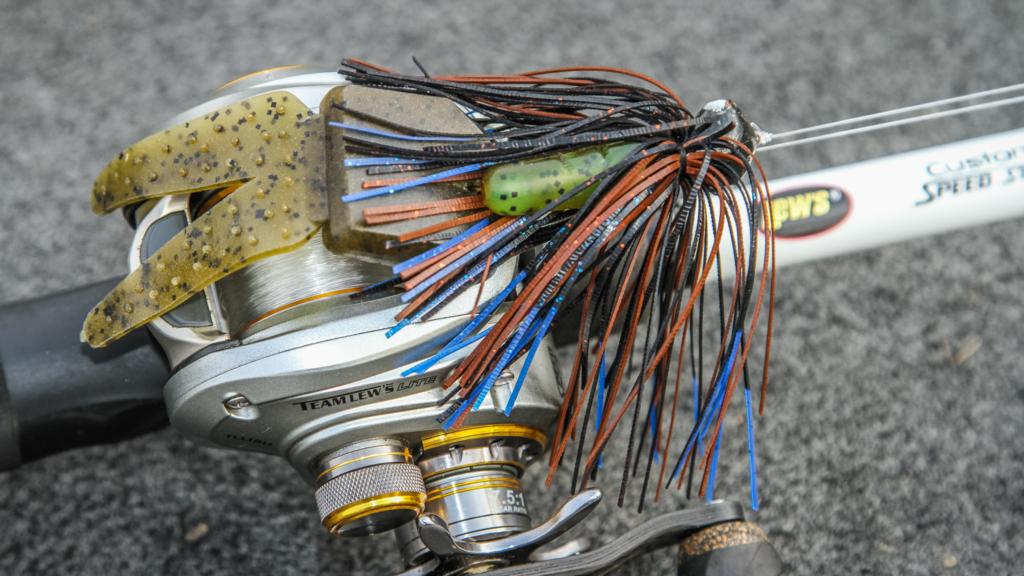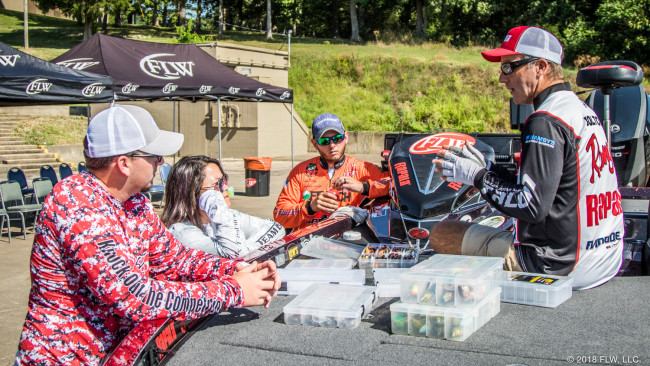Using Chunks Doesn’t Make Me a Dinosaur
The Zoom Chunk family of trailers is old school, but what’s wrong with that?

I’m 48 years old, but until a month ago I didn’t realize that made me a dinosaur. Well, I at least felt like a dinosaur a few times while I was conducting a seminar at the Costa FLW High School Fishing Summer Camp at Kenlake State Park. My age showed again when I competed with a couple of local high schoolers in the FLW Foundation Marshall Strong charity tournament on Kentucky Lake.
And no, I didn’t feel that way because I’m not familiar with the latest Googan Squad video. It was because I still use chunk trailers. How 1990, right?

The situation started at camp, when I was describing some of the ways I store my soft plastics to a few student participants. One of the tackle boxes I showed them was a “big box of chunks” I keep in a deep Plano StowAway that dates back to when I made the T-H Marine BFL All-American in Huntington, W.Va, in the late ’90s. I met my good friend Andy Morgan at that tournament, back before we could ever be considered dinosaurs, when he and I were both budding tournament pros and fans of the Zoom Chunk and its many iterations. When I saw how many types of chunks and colors that Morgan had with him in his boat, I knew I needed to expand my collection. Hence the big box of chunks I now carry.
When I showed that box to the students, I got some unexpected reactions.
“Wow, you must like chunks,” one of them said.
“Why do you have so many chunks?” another asked. “We never fish chunks.”
Even fellow FLW Tour pro Cody Kelley, who joined me at the seminar and isn’t that much younger than me, chimed in.
“You sure like those old-school chunks,” he said.
Old school? You’re hurting my feelings.
I got the same reaction from my high school teammates at the charity tournament on Saturday after camp. They were fishing other more modern creature and craw trailers on their jigs, and I was plugging away with my classic Zoom Chunks.
“Why do you throw chunks,” one of them asked me.
I tried to explain that when I was his age, all we had were pork trailers and eventually chunks. They’ve worked for 35 years, and they still work now.
He seemed skeptical. I explained that, in late summer, a chunk is a great jig trailer because the fish like to suspend, and the right chunk can really slow the sink rate and get those suspended bass to bite. I told them they should always be prepared after the cast to set the hook as soon as they picked up on the jig. Those fish will eat it on the fall … if the presentation is right.
I wasn’t making much progress convincing my younger tournament partners until I did exactly as I described. I made a cast, picked up on my line and felt what turned out to be a 4 1/2-pounder swimming away with it.

Awhile later, I did the same thing on a 5 1/2-pounder as my jig tumbled over the limb of a brush pile.
I guess young folks learn better by example, because by the end of the day everyone in my Ranger was fishing a chunk on the back of his jig. We ended up weighing in 17 pounds, 8 ounces and finishing fourth. We didn’t earn any money, but we helped out a great cause, and I like to think I taught those boys a lesson that can help them improve their jig-fishing skills.
So what is it about a chunk that makes it such a great option as a jig trailer? For me, it’s all about the ability to customize a jig presentation. Chunks, while they lack a lot of flapping, fluttering action, contribute to a nice gliding presentation on the fall. By choosing the right size and style of chunk, I can really dial in the sink rate. I like that feature.
In clear water, I really like my jig to sink quickly. It gives bass less time to study the bait and spot that it’s not a real meal. In dirty water, I want to slow down my presentation so fish can find it. I also like it to sink slowly in cold water, when bass aren’t too aggressive.
I can go either way by choosing the right chunk. A big, meaty chunk like the Zoom Big Salty Chunk or Super Chunk has broad appendages and a lot of plastic in its profile, and that creates drag in the water that slows the descent. A smaller option, such as the Zoom Super Chunk Jr., encounters less resistance. Of course, you can further dial in the presentation by adjusting jig size. It’s all about finding that “just right” balance.
A bigger chunk is also my preferred choice for skipping docks. That broad, flat surface acts like the flat face of a good skipping stone.
This is all stuff that those of us who’ve been around the fishing block started figuring out back in the days of the Uncle Josh Pork Frog. That was the original jig trailer, but it had its drawbacks. If you left it out on the deck too long in hot weather, the pork dried out. Or if you spilled the salty brine out of the jar it came in, you couldn’t replicate the effects of the brine with just any old water. Plus, not all Pork Frogs were the same. We used to open jars in the tackle shop and peek at the pork inside to see which ones were trimmed just right. Fishing life was tough in those days …
After the Pork Frog, we eventually got more jig trailer options. There was the Gene Larew Salty Craw, and then, when Guido Hibdon won the Classic with a Guido Bug, his trailer became the hot ticket.
When Zoom’s plastic Chunk came out, it really just opened things up for us. You didn’t have to worry about your pork drying out. You had good flexibility. They were all really consistent. I, like many, was won over.
I suppose that’s similar to how it is today. Every year, a new latest-and-greatest jig trailer comes out that everyone wants to fish. They all advertise more action and better action and on and on. But that doesn’t mean they should replace what has and always will work. Besides, action isn’t what I’m looking for in every situation.
I use a more modern craw or flapping trailer with moving pincers in May and June, when fish are usually very aggressive. I also like a twin-tail bait or something similar when dragging a football jig, which stays on the bottom during the retrieve.
I go back to the chunk when the presentation involves a jig not glued to bottom. That applies to casting jigs early in the year when the water is cold, or in dirty water or when they’re suspended along edges and brush. A chunk is often my choice for swimming a jig, because the flat surface helps me keep the bait up. I also use one on a flipping jig, or for pressured fish that are more likely to eat a jig with a trailer that’s not flapping all over the place.
My last bit of advice relates to colors. I don’t carry many jig colors. Black and blue or green pumpkin cover a lot of scenarios, with a couple others for specific situations. Yet I can manipulate my color profile by keeping all sorts of chunk colors on hand. A black or black and blue chunk will darken the profile. Green pumpkin chartreuse lightens it up. Sapphire blue is very bold and has a lot of applications too. You get the point: Carry fewer skirt colors and more chunk colors to expand your range.
It seems ironic to me that, when I was coming up in the sport, the problem we had was not having enough options. That slimy pork was the best thing out there. Today, young anglers almost suffer from the opposite: fishing tackle overload. There are thousands of soft plastics and hundreds of jig trailers. I now understand why the simple chunk might go overlooked. I just don’t think it should. I’m not saying it’s the one and only, but it certainly has its place.
After all, they’ve bit it for 35 years, and they still bite it today.